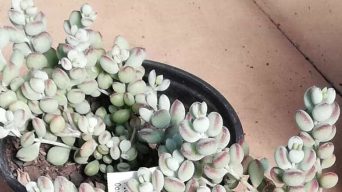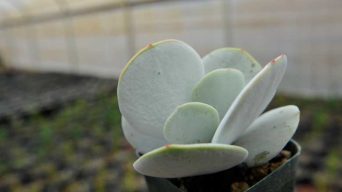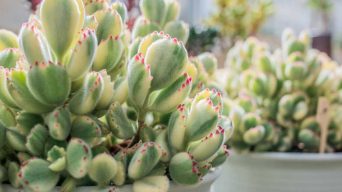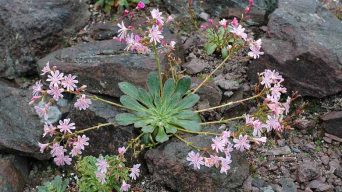If you’ve ever grown a succulent plant, then you know how rewarding it can be to watch your little plant grow and thrive.
However, succulents can also be relatively high maintenance if you don’t know how to care for them properly. If you’ve never dealt with a succulent before, you might not even know where to start.
The good news is that caring for a succulent plant isn’t difficult at all. You need to research how different species of cactus and succulents grow and then take the time to learn about your specific types of plants.
The Cotyledon tomentosa subsp. ladismithiensis (Bear’s Paw), or simply known as Cotyledon ladismithiensis, is a popular succulent plant that looks spectacular in pots and gardens.
It’s relatively easy to grow, but it does have specific needs. Learning the right way to care for this beautiful endemic species will help ensure that your plants survive and thrive.
This article provides you with everything you need to know about caring for cotyledon ladismithiensis plants, from the best soil and pot sizes to watering schedules.
You’ll also find some helpful advice about propagating your succulent cuttings so that you can share your plant with friends or sometimes even make a little money off of them!
Overview
Cotyledon Ladismithiensis is an evergreen, perennial, succulent shrub that grows in arid regions of South Africa.
It has a stem that can be up to 20 mm in diameter and up to 1 foot tall, with leaves that are epetiolate with short white hair at the edges.
This plant is known for its distinctively shaped leaves and dense clusters of pink flowers.
Inflorescences are approximately 160 mm long, and flowers are cup-shaped with five fused petals with slight orange coloration.
It flowers during the summer months of June through September with white flowers that resemble snowdrops or crocuses.
How To Care for Cotyledon Ladismithiensis
Below you’ll find the essential information you need to know about caring for Cotyledon tomentosa ladismithiensis ‘Variegata’.
Sun Exposure and Light Requirements
The Cotyledon ladismithiensis succulent plant is a popular member of the Crassulaceae family because it’s an easy-to-care-for houseplant.
It enjoys receiving at least four hours of bright, indirect light daily and thrives in partial sun to partial shade.
Place your plants near a west-facing or east-facing window that gets plenty of bright, indirect light for the best results.
However, if placed in high-light conditions for too long, your plant will “burn out” and look dry and withered.
If placed in low-light conditions for too long, your Cotyledon ladismithiensis succulent will lose much of its coloring and may become leggy.
The stems may also become weak and stretch out, looking messy. If this occurs, simply move the plant to a sunnier position and allow the soil to dry completely before watering.
Additionally, if planted outdoors, the Cotyledon ladismithiensis succulent should receive partial shade, especially during the hottest parts of the day.
Watering Requirements
Cotyledon Ladismithiensis succulent plants need to be watered once a week, allowing the soil to dry out before watering deeply and avoiding overwatering them.
This is important because they are susceptible to overwatering. If left in wet soils, they are likely to rot. Watering them on the leaves is also harmful, as this may lead to the development of fungal diseases.
When watering, you should water until the soil is wet and then allow it to dry out before watering again. This way, they can get enough water for their roots, and at the same time, they don’t remain continuously in a wet environment.
They should never be water-stressed, and it is important to withhold watering during winter. During this period, they require very little water.
You should only water the plant when the soil feels dry, and by simply sticking a finger in the pot, you can quickly tell if the soil needs watering or not.
If the soil is wet or moist, this means that it already has enough water, and you should avoid watering.
Soil Requirements
The soil requirements of the Cotyledon ladismithiensis succulent plant are simple and easy. The Cotyledons like loose, well-draining soil such as a cactus or succulent mix.
This type of soil is typically a mix of sand, perlite, and vermiculite, which is perfect for cotyledons to thrive in.
Potting soil or garden soil is not ideal as it can hold too much moisture. Not only does this affect the Cotyledon’s chances of survival, but it can cause root rot.
Temperature and Humidity Requirements
The Cotyledon ladismithiensis succulent plant is a desert plant that grows in the arid regions of South Africa.
They are very hardy plants and can survive extreme conditions, but they have temperature and humidity requirements to keep them healthy.
If you Cotyledonledon ladismithiensis plants to thrive, then it needs a daytime temperature range of 68° – 80° Fahrenheit (20 – 27°C) during the day, and nighttime temperatures of 50° – 70° Fahrenheit (10 – 21°C).
Cotyledon ladismithiensis plants also need around 40% relative humidity.
Fertilizing Cotyledon Ladismithiensis
Cotyledon ladismithiensis succulents are desert plants, so they do not need fertilization often.
They need to be fertilized once in a while during the growing season to help promote root growth and replenish nutrients.
Cotyledon ladismithiensis succulents benefit from occasional fertilization in the growing season, but it must be done with a balanced liquid fertilizer diluted to half-strength.
Any excess of nitrogen from fertilizers can lead Cotyledon ladismithiensis succulents to have reddish-purple leaves and weaken them over time. They should not be fertilized in winter; excess fertilization can burn their roots.
Potting and Repotting
Cotyledon Ladismithiensis succulents are slow-growing and rarely need repotting.
This is very good for beginners who may kill Cotyledon Ladismithiensis by caring too much or too little.
Cotyledon Ladismithiensis succulents must be repotted every few years to prevent them from becoming rootbound.
When repotting Cotyledon ladismithiensis, make sure not to damage the root system and use a pot with drainage holes at the bottom.
It’s recommended to repot Cotyledon Ladismithiensis in the spring as new buds emerge and before blooms.
Always use a pot that is a few inches larger than the Cotyledon Ladismithiensis already in it.
Pruning
The Cotyledon ladismithiensis is a popular, low-maintenance houseplant. It is easy to take care of and relatively hard to kill.
However, pruning the plant is necessary to maintain good health for the plant.
There are several reasons why pruning is necessary.
Pruning helps to maintain proper air circulation around the plant, preventing fungus and other diseases from developing.
Pruning also forces the plant to produce new healthy growth, leading to an overall healthier plant that requires less care than a diseased one.
Occasionally you will need to remove older leaves or stems to make room for new growth.
The Cotyledon ladismithiensis is not a fast-growing plant and can go months without needing to be pruned.
Pruning should only be done when the plant requires it; otherwise, it will not grow as quickly or become as healthy.
Pests and Diseases
It’s good to know what diseases and pests may affect the Cotyledon ladismithiensis succulent and how to prevent them.
While not a particularly delicate houseplant, the Cotyledon ladismithiensis succulent is still prone to certain pests and diseases that can infect any plant.
The most common pests and diseases that affect the Cotyledon ladismithiensis succulent plant are:
Mealybugs
Mealybugs are tiny, sap-sucking insects that appear as white, fuzzy patches and can be found at the tips of leaves and long stems.
They multiply quickly; if left untreated, mealybugs can completely cover a plant in a short time.
Spider Mites
Other pests that affect the Cotyledon ladismithiensis are spider mites.
Spider mites pierce the leaf tissue with their mouthparts to ingest stored sap, effectively “draining” the plant as they feed. The results are small brown or yellow spots on leaves and webbing on the lower leaf surface.
If left untreated, spider mites can quickly kill a succulent plant.
Scale Insects
Scale insects look like small disks on stems and leaves; they’re immobile parasites that cause damage by feeding on sap.
Infected plants typically display yellow spots or brown, wilted leaves and often have an unpleasant odor.
Fungal Diseases
As with most succulents, the Cotyledon ladismithiensis succulent is susceptible to fungal diseases.
Fungi are rarely dangerous when they appear on a plant’s leaves, but their presence can lead to rot if they spread downward into the stem.
Leaves affected by fungus may wilt or turn dark; in some cases, leaves may fall off the plant.
Prevention Tips
Providing proper care to your succulents will help prevent pests or diseases from attacking them.
Ensure that you’re properly watering your plant; overwatering is one of the most common causes of pest infestations.
Ensure that your plant’s container has proper drainage; water sitting at a pot’s bottom can lead to root rot or fungus.
It’s also essential to keep succulents out of direct sunlight, especially during summer.
Another way to help prevent infestations is simply keeping your plant clean. Wipe leaves regularly with a damp rag to remove dust and dirt that could attract pests or harbor fungi.
Always wash your hands before handling your plant, as bacteria and other microbes can spread from person to plant if you don’t do so beforehand.
Finally, quarantine any new plants for at least two weeks before introducing them to your existing collection.
This will allow you to monitor the new arrival’s health without risking damage to existing succulents.
If your new plant is harboring any pests or diseases, this will protect your existing collection from exposure to them.
How to Care for Cotyledon Tomentosa Subsp. Ladismithiensis in Winter
The Cotyledon ladismithiensis succulent plant is best kept inside during the coldest months of winter.
If you live in a milder zone (zone 9+) with no freeze, it can be grown outdoors all year around. But for people who live in an area with colder winters (zone 8 or below), bringing the plant indoors before the first frost is recommended.
The plant can be overwintered by bringing it indoors when the temperature outside drops below 40°F (5C).
Then store the potted plant in an unheated room or garage. Keep it dry, but not too dry.
When the plant returns outdoors, you must cut off dried-up leaves and repot them in well-draining soil.
During the winter months, keep the plant dry and reduce watering.
The Cotyledon ladismithiensis succulent plant does not do well in the cold and wet. Any water on the leaves can lead to bud rot and leaf spot diseases, which will cause your plant to die.
When you bring the plant inside, place it in a sunny window, but not too close to the window, as this will cause it to dry out. The ideal temperature indoors during the winter is around 65°F (18C).
As summer approaches, you can place your plant back outside. Make sure to acclimate it slowly.
Move the plant outdoors during the day and bring it in at night for about a week before leaving it out all night.
How To Propagate Cotyledon Ladismithiensis
You can propagate cotyledon ladismithiensis by planting its seeds and taking stem cuttings.
Cuttings
When propagating cotyledon ladismithiensis, the best option by far is to take stem cuttings. This plant is very easy to propagate using this method and tends to root quite quickly.
Firstly, you will need to take your cutting from healthy stems. Then place it in an area where there is indirect sunlight, such as the underside of a table.
Once placed there, remove any leaves from the bottom third of the stem and allow it to dry for about one week.
Water sparingly during this period, and once you see roots growing from your cutting, place it in good quality soil in a pot that is only slightly larger than your original cutting.
Keep the soil moist but not wet, and after about a month to six weeks, you will notice that your cotyledon plant is beginning to grow at an accelerated rate.
Once this occurs, it will be necessary to repot your plant into larger pots as it develops more roots and begins to form sturdier stems.
Seeds
The seeds of cotyledon ladismithiensis are large and take about 45 days to germinate.
Sow these seeds in an area that receives full sun and press them into the soil with a gentle pat before covering them entirely with soil.
Water daily until your plant begins to sprout, after which you can water less frequently.
Once established, your cotyledon ladismithiensis plant will grow at an accelerated rate.
These plants are highly adaptable and grow well in dry climates, but be sure to monitor their watering closely to ensure they are neither overwatered nor underwatered.
Is the Cotyledon Ladismithiensis Toxic?
When there are reports that some succulents are mildly toxic, using them as indoor decoration can be scary. However, the Cotyledon Ladismithiensis is generally considered non-toxic.
There is a high probability that the Cotyledon Ladismithiensis will have no symptoms from being mildly toxic.
However, it is still safe to keep in mind that although these plants are non-toxic, they can cause mild irritation if ingested.
It’s always recommended to wash your hands after handling any plant.
You can use gloves if you’re going to be touching the Cotyledon Ladismithiensis a lot, just as a precautionary method.
Final Thoughts
Caring for and propagating the Cotyledon tomentosa subsp. ladismithiensis plant is not difficult. All you need is the proper knowledge and plan of action.
Caring for your plant will lead to a vigorous succulent with an extended lifespan if done correctly.
Furthermore, you will receive some great succulents that can be given to friends and family or kept as a beautiful memento of your care.
After learning how to care for this species, I am more than confident that the Cotyledon ladismithiensis is easy to take care of and great fun.
It’s a great addition to any succulents collection and should be given a try.







